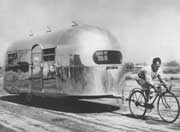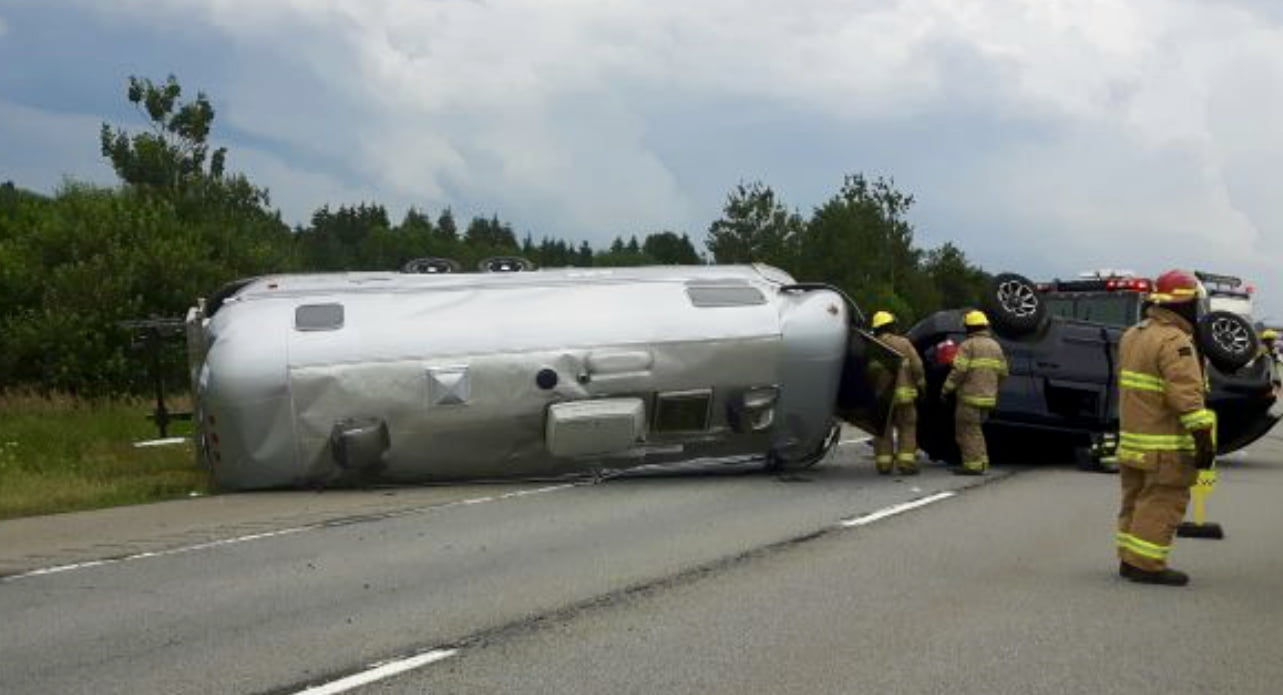Cause of Trailer Rollover/Sway Part 1
I have been with the Airstream Forum since 2018 and been intrigued by the different suggestions made by different people about questions regarding tow vehicles, trailer size and hitch set-ups. Often the question begins with; “Can I tow my 30′ Airstream with a F-150” (hypothetical question). Think about this question a minute …. What is the TRUE question being asked?
Answer: The TRUE question being asked is whether the marriage between the Tow Vehicle and the Travel Trailer is correct for safety, security, capacity and function? Because you can “tow” an Airstream with a bicycle.
What do I mean by “safety, security, capacity and function” ?
As they say a picture is worth a thousand words.
Why do “Rollovers” happen? How can they be prevented? What are the underlying causes? Rollovers and other mishaps take place every single year with all types of travel trailers (just view them on YouTube). AND! I might add, this can happen towing an Airstream ☹ sad but true.

Most Common Causes of Travel Trailer “Accidents”
Some of common causes of Travel Trailer accidents overlap with causes of Automobile accidents. However, travel trailer accidents are exacerbated when towing simply because of the sheer size, coupled with reduced visibility and manoeuvrability as well as the lack of towing familiarity (I use this word “familiarity” because most of us are “vacation” summer campers. Thus the “towing” complicities can “slip” out of the mind 😵).
Summary List of Reasons for Travel Trailer Accidents:
I decided to layout this “summary list” of causes to think about. When you read through it, you can begin to see there are different categories of cause: The Driver; The Environment; The Relationship between Tow Vehicle and Travel Trailer.
- Inexperienced drivers (both newbies and the sometimes)
- Overtired drivers (sometimes those who have a beer to go)
- Failing to see another vehicle in the lane beside the trailer due to a blind spot
- Speeding
- Miscalculated stopping distances (heavy vehicles require longer stopping distances)
- Poorly calculated turns (especially right turns)
- High winds (both nature and the passing semi)
- Steep grades (Runaway trailers)
- Bumpy or Curvy or Wet Road
- Overloading the trailer with too much weight aft (adding a heavy item on the rear)
- Rollover caused by higher centre of gravity (both Tow Vehicle and Trailer)
- Poorly balanced loads
- Short Wheelbase Tow Vehicle
- Lack of – not proper: Weight Distribution/Sway Control Hitch (Ball only)
- GVWR of trailer more than 50% of Tow Vehicles GVWR (tail wag syndrome)
- Trailer Weight greater then the Designed Towing Capacity of Tow Vehicle
- Having too light tongue weight (the magic 10-15%)
- Improper tire pressure/tire failure
Let’s look at some of the most prominent of these factors without making this Blog Post too long.
Hitch Ball Only:
When you think about the pivot point between the Tow Vehicle and Travel Trailer it is where they attach – i.e., The Ball!
Any travel trailer being towed behind the rear axle of the tow vehicle can sway (fishtail – as show in the video above). Thus the hitch ball, acting as the pivot point in-between the tow vehicle and travel trailer will, with side-to-side force, create an unexpected steering difficulty. Further, if that sideways force is strong enough it can overcome road-tire friction on both the travel trailer and then the tow vehicle. The end cause is a rollover or separation of the travel trailer. Any rollover may well include the tow vehicle 💀.
Tow With the Wrong Tow Vehicle:
Whether you’re looking to buy a travel trailer or you already own one, you must know if your tow vehicle and trailer are a good match.
At a very minimum – Locate the Gross Vehicle Weight Rating (GVWR) of your tow vehicle. This represents the maximum weight your tow vehicle can carry, including passengers, cargo, fuel and the vehicle itself. Next, find the Gross Trailer Weight Rating (GVWR) of the travel trailer you want to buy. This represents the maximum “wet weight” of your trailer when loaded (the trailer, water, LP, batteries, stuff). Compare the two figures. If the GVWR of the travel trailer exceeds 50 percent of the GVWR of the tow vehicle, then you must have an anti-sway hitch system installed to control the “tail wagging the dog syndrome“. If you don’t, the chances of you becoming a sad statistic are inevitable. Needless to say there is much more to consider regarding tow vehicles – size does matter here, just saying.
Improper Trailer Loading and Tongue Weight:
Loading too much gear on one side of a travel trailer can also cause an imbalance, making them swing more dramatically once a sway starts. This can also make your travel trailer more likely to suffer tire failure due to unequal weight and heat and/or additional braking and steering problems. Another loading issue is adding weight to the rear of the travel trailer – the pendulum swings like the pendulum do – did you notice the “extra” stuff attached to the rear of the trailer in the above video?

Balancing weight to the forward and rear is required for controlled driving. The basic rule is between 10-15% of the travel trailer’s weight should be resting on the tow vehicle’s hitch ball. Any less weight forward may pull up on the tow vehicle’s rear wheels just when you need more traction and control. However, drivers have to be careful not to exceed the tow rating of the tow vehicle’s hitch (tongue) weight.

Wind and the “Wave”:
Trailer sway can be a result of crosswinds and drafts from passing semi-trucks who push a “wave” of air in front of them. As the Semi-Truck passes, it cause a suction which tends to draw the travel trailer into the void space. This alone can cause sway – worse case, literally suck the trailer into the passing semi.

While the front of most travel trailers are aerodynamic to improve towing gas mileage, the sides are not. A 55km (35mph) crosswind can put as much as 1500k (3,400lb) of force pushing on the side of a large travel trailer. One strong blast of wind from the side can cause problems for any vehicle and can become more hazardous still if there is a large travel trailer involved. The end result could find the tow vehicle swinging back and forth as the tail begins to wag the dog.
Speed and Road Conditions:
One of the main reasons travel trailers sway is high-speed driving. When you drive over the suggested manufacture recommended speed (Airstream recommends max 105km per hour/65mph), a travel trailer becomes less stable and can begin to sway even with the slightest wind. It can also begin to sway simply by hitting a “bump” in the road which throws the balance off. This can be aggravated quickly on wet pavement where there is less traction.
It’s important to remember that while the tow vehicle is stopping/slowing down when braking, the travel trailer is still wanting to move at the original speed. Think about this when descending hills using incorrect braking technique.
Tires:
One last thing I would like to mention … think about the importance of your tires on both the tow vehicle and travel trailer. Each tire sits on a very small connection to the ground. If it’s wet, the connection become tenuous. If over inflated they bounce. If under inflated they fail to support the load which can accelerate sway (also they heat up and explode). It is important to follow the manufacture recommendations for tire pressure which is based on the travel trailer axle number and GVWR.😎
AND there is ….
“I was told by the person who sold me my Airstream that this was perfectly safe and my vehicle could tow this trailer – no problem! The size of the tow vehicle is not important.” (so they say)

Big tail – small dog ….

Big tail – small dog ….

Big tail – small dog ….

Big tail – small dog ….
In Part 2 of this Blog series I will discuss the importance of techniques and equipment to prevent and correct travel trailer sway. Go here to read.
